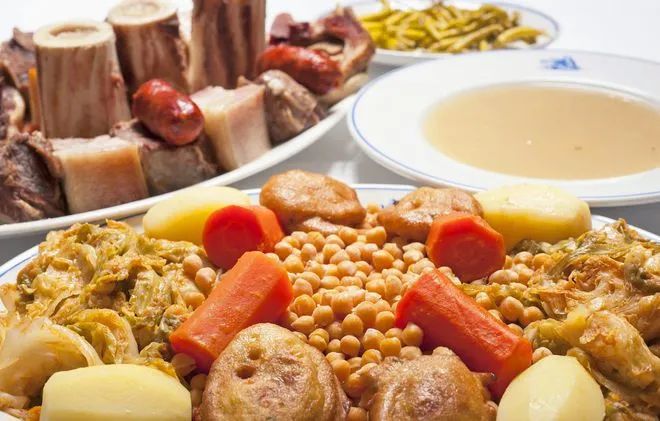In Europe, compared to the refinement of French cuisine and the fusion of Italian meals, our understanding of the culinary delights of Spain is relatively limited. For many, the impression may be confined to Spanish seafood paella, and due to concerns about undercooked rice, some may not be enthusiastic about this dish. So, besides paella, what other culinary treasures does Spain have to offer?
Conejo con arroz
Conejo con arroz is a traditional Spanish dish that combines rice and rabbit meat. Throughout Spain, it takes on various forms, with some people preparing it in the style of seafood paella, where rabbit meat is placed atop a thin layer of rice.

In addition to rabbit meat and rice, other typical ingredients include onions, tomatoes, chili peppers, carrots, garlic, and olive oil. It is seasoned with saffron, bay leaves, paprika, salt, and pepper.

Paella
Paella is the initial impression many people have of Spanish cuisine. It combines saffron-seasoned rice with a variety of ingredients such as seafood, vegetables, or meat—although it is often referred to as “Spanish seafood rice,” not all paellas include seafood.

The original Paella was crafted in Valencia, made with seasonal vegetables, poultry, and rabbit. There has been ongoing debate about the authentic ingredients used in Paella, but there is unanimous agreement that it should be seasoned with saffron. Another key element is the crispy layer of rice, known as “socarrat,” at the bottom of the paella pan.

Pisto
Pisto is a traditional Spanish dish originating from La Mancha, consisting of various cooked and sautéed vegetables such as tomatoes, onions, bell peppers, and zucchini. It bears a striking resemblance to the famous French ratatouille. This dish can be served as a cold appetizer or heated as a side dish.

It is said that this dish was introduced to Spain by the Moors, who once referred to it as “alboronia.” Pisto also has many variations, with ingredients such as potatoes, pumpkin, or ham being added to it.
Puchero
Puchero is a Spanish stew, a popular comfort food made with various types of meat, rice, noodles, and vegetables (such as chickpeas, cabbage, carrots, and potatoes).

Its name, “Puchero,” translates to “stew pot,” referring to the large earthenware pot originally used to prepare it. Traditionally, puchero is consumed over several days, with different side dishes accompanying each serving.
Marmitako
Marmitako is an excellent representation of Basque country cuisine. It is a stew made with various ingredients such as tuna, potatoes, tomatoes, peppers, and onions. The name of the dish comes from the Basque word “marmita,” which means pot or casserole.

Originally invented on fishing boats near the Spanish coast, Marmitako was created using tuna as the most authentic choice. However, today the dish has many variations, depending on the type of fish used during preparation.

Fabada Asturiana
Fabada Asturiana is the signature dish of the Asturias region in Spain. It consists of white beans, sausage, blood sausage, and bacon, all simmered in a buttery chicken broth seasoned with smoked paprika, garlic, and saffron.

It has a zesty and refreshing taste with a rich earthy flavor. It is said that this dish first appeared at some point between the 19th and 20th centuries.

Cocido
Cocido is a traditional Spanish stew with many variations. The name “Cocido” comes from the word “cocer,” meaning to boil, and it is typically simmered slowly over low heat. It is also popular in Portugal and Brazil.

This stew is a mix of various meats (sometimes seafood) such as chicken, beef, pork, and lamb, along with cured sausages and dry chorizo. Vegetables like carrots, chickpeas, potatoes, turnips, and cabbage are also included. Additionally, other ingredients such as cheese or eggs may be added to enhance its flavor and texture.




